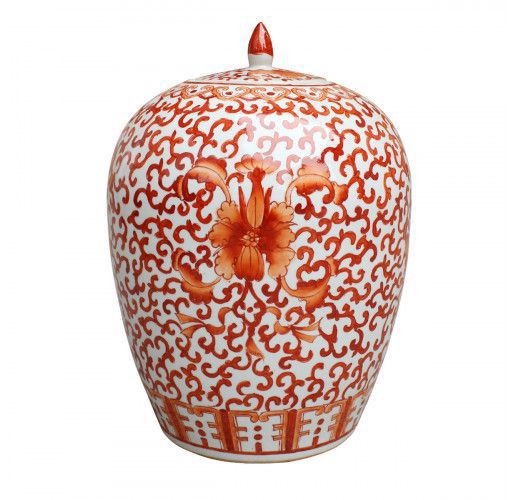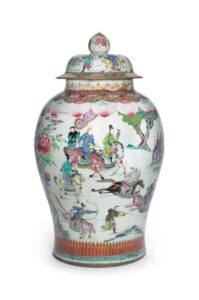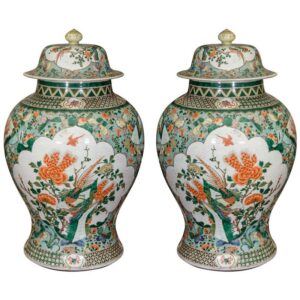I threw a picnic in our garden the other day. We were busy with all…
Ginger Jars – Classical English interior accessories
Not sure about you but I am absolutely obsessed with blue and white ginger jars. Needless to say that these ginger jars are typical accessories of the English home. Whether a smaller town house or country house, you would find a couple on the mantelpiece in many houses. Occasionally you would find one on a console table, or it comes in a form of a lamp, but it can also be a giant one standing next to the fireplace or a mirror. Wonderful. Absolutely wonderful. I have no idea why I am mad about them… whether it is the shape or the design, I don’t know. What I do know, is that if we lived in a period property and had a fireplace, the first thing I would do is to buy a ginger jar. Or a couple to be precise and mind the symmetry – just like Poirot would. 🙂
But why did ginger jars become such an iconic element of the English interior?
Ginger jars already existed during the Qin Dynasty (221 BC – 207 BC) and were used to store salt and ginger. Later ginger, spices, herbs, salt and oil was exported in ginger jars to the West.
Europeans (just like me!) were crazy about ginger jars which was in high demand along with tea cups. The jars become an ornament of the home in the 18th and 19th century, mainly because of the good quality of the china, secondly because of its aesthetic appearance. Ginger jars were made by potters and were hand-painted by skilled artists. The majority of ginger jars were made in Jingdezhen. The town’s earlier name Changnan gave the English word „china” when Europeans failed to pronounce it.
Patterns and colours
The main patterns are traditional Chinese patterns such as flowers, landscapes, animals, dragons. The main colour categories are:
- Blue and White
- Yellow, orange and red
- Imari
- Famille Verte and Famille Rose
- Cinnabar
Blue and White
The traditional blue and white ginger jars are the oldest designs from the Ming-dynasty (1368-1644) and these were the first ones to reach Europe. This is the reason why they are still so popular and there are so many of them. Often it is difficult to tell the age of the jar, but as a general rule, jars made before the 19th century are much heavier. The reason being that porcelain was imported with tea, but porcelain was originally the ballast of the ship. Ginger jars were filled with heft (extra weight), so the jars had to carry more weight and were therefore more substantial in structure.

Yellow, orange and red
These are the rarest colours to find. Yellow was associated with the Emperor of China, so this colour was reserved for luxury and special goods. (They are so rare, that I could not even find an image! Only a red one…)

Imari
Imari ware is a brightly coloured porcelain where patterns are painted with blue, red, black and gold. The design is of Japanese origin and comes from the port of Imari in Japan. The Dutch East India Company started to export the Imari ware to Europe from Japan at the end of the 17th century when China was in political chaos and kilns in Jingdezhen were damaged. The Japanese export stopped in the mid 18th century as they could not compete with China, who restarted production. By this time the Imari ware was so popular that both China and Euorpe started to copy it.

Famille Vert and Rose
The green enamel design is older than the rose. On the Famille Vert, items designs were drawn with black outlines except the figures faces which were outlined in red.
Famille Rose appeared later and the colour arrived from Europe to China. It is often referred to as ‘fencai’, which means foreign colour. Jars are decorated with birds, flowers etc. What gives you a clue whether the piece is original or not, is that flowers on genuine pieces look more Spring-like.
Cinnabar
In the 14th century, during the Ming-dynasty carved jars and vases were dyed red for which they used a red mineral, called cinnabar. Red was a popular colour in China because it has long been associated with good fortune.

If you would buy…
- The value of ginger jars depend on their age, colour, rarity and condition and whether it has a lid!
- Lids are often lost, so a lid adds value.
- The quality of the painting reveals whether it is a genuine item, or a fake one. An expert is required to identify that.
- Almost all jars have reign marks on the base that tell you which emperor and dynasty the jar was made under. However, this also can be tricky as often potters carried on making jars in the previous stlye to make replicas (not to fake them) and to be authentic, they used the appropriate sign.
~
Well, if you would like to create an English feel at home, I think ginger jars are necessary. But be cautious! Ginger jars can cost £20 and £500,000. I think I would be happy with a £20 one. Blue and white of course and with a lid because that’s my favourite. 🙂
Which one is yours?






I have blue andcwhite ones but also interested in others. Lately i have been focused on the tiny miniature ones. I have one that is about 2 inches tall and just ordered one from Mecari that is slightly larger.
Oh you are so lucky, Wendy! I am still looking for the perfect size, shape and colour. 🙂
I too collect blue and white.asian porcelain.